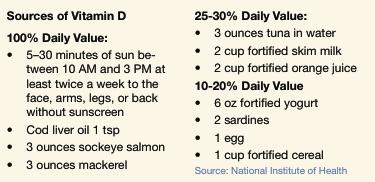Vitamin D Bread?
 Unless you spend most of your day in the sun, drink more than three cups of D-fortified milk per day, or are particularly fond of fish and mushrooms, chances are you belong to the 70% of Americans who are vitamin D deficient (1). When exposed to the sun our skin makes vitamin D from a derivative of cholesterol, but there is a limited number of nutritional sources that are ubiquitous enough in the American diet to provide the daily requirement (2). D-fortified milk is one, but many scientists and health professionals think this food causes more health problems than it cures (3). On the other hand, bread, or more precisely bread made with D-rich yeast may provide a new way to close this national “D-gap.”In January 2010, Connie Weaver and her research group at Purdue University reported on a study designed to measure the relative effects on bone health of vitamin D supplements compared to bread prepared with D-rich yeast (4). The group found that while the supplement gave a higher concentration of a blood marker for vitamin D, the sources were identically beneficial to bone health. Both the supplement and the bread produced recovery in the vitamin D deficient subjects and increased bone density as well as thickness. Likewise, there was no significant difference between the two sources in increasing mineralization (i.e. bone calcium absorption) and general bone strength.Since vitamin D controls calcium absorption from blood, and calcium is an important part of bone structure, it’s not surprising that a deficiency in D is the cause of rickets and a risk factor for osteoporosis. However, since calcium serves health functions other than bone development and maintenance it’s also not a shock to find that vitamin D deficiency has been implicated in other maladies including severe asthma in children, diabetes, and cardiovascular disease.Low D may even play a role in the depression of seasonal affective disorder (SAD), although the accompanying lack of the vitamin could be a result of low light exposure rather than a cause of the depression.Given the relative rarity of vitamin D in our diets, the increased use of sunscreens, and the potential negative effects of milk, the need for a new widely consumed source of this nutrient seems obvious. Although Weaver’s work showed that a supplement produces a higher blood concentration of the D marker, closing the D-gap using another widely consumed food might be the strategy of choice.By Dale E. Vitale, Ph. D, Chemistry-Physics Dept. Kean UniversityReferences:1. Arch. Intern. Med. 2009, 169, 626-632.2. Mayo Clinic, http://www. mayoclinic.com/health/vita- min-d/NS_patient-vitamind, last accessed 5-26-2011.3. ProCon.org, http://milk. procon.org/view.answers. php?questionID=1317, last accessed 5-28-2011.4. Hohman, Emily E. Martin, Berdine R., Lachcik, Pamela J., Gordon, Dennis T., Fleet, James C., Weaver, Connie M., Bioavailability and Effi- cacy of Vitamin D-2 from UV- Irradiated Yeast in Growing, VitaminD-Deficient Rats. J. Agricultural and Food Chem- istry, 2011, 59, 2341-2346.
Unless you spend most of your day in the sun, drink more than three cups of D-fortified milk per day, or are particularly fond of fish and mushrooms, chances are you belong to the 70% of Americans who are vitamin D deficient (1). When exposed to the sun our skin makes vitamin D from a derivative of cholesterol, but there is a limited number of nutritional sources that are ubiquitous enough in the American diet to provide the daily requirement (2). D-fortified milk is one, but many scientists and health professionals think this food causes more health problems than it cures (3). On the other hand, bread, or more precisely bread made with D-rich yeast may provide a new way to close this national “D-gap.”In January 2010, Connie Weaver and her research group at Purdue University reported on a study designed to measure the relative effects on bone health of vitamin D supplements compared to bread prepared with D-rich yeast (4). The group found that while the supplement gave a higher concentration of a blood marker for vitamin D, the sources were identically beneficial to bone health. Both the supplement and the bread produced recovery in the vitamin D deficient subjects and increased bone density as well as thickness. Likewise, there was no significant difference between the two sources in increasing mineralization (i.e. bone calcium absorption) and general bone strength.Since vitamin D controls calcium absorption from blood, and calcium is an important part of bone structure, it’s not surprising that a deficiency in D is the cause of rickets and a risk factor for osteoporosis. However, since calcium serves health functions other than bone development and maintenance it’s also not a shock to find that vitamin D deficiency has been implicated in other maladies including severe asthma in children, diabetes, and cardiovascular disease.Low D may even play a role in the depression of seasonal affective disorder (SAD), although the accompanying lack of the vitamin could be a result of low light exposure rather than a cause of the depression.Given the relative rarity of vitamin D in our diets, the increased use of sunscreens, and the potential negative effects of milk, the need for a new widely consumed source of this nutrient seems obvious. Although Weaver’s work showed that a supplement produces a higher blood concentration of the D marker, closing the D-gap using another widely consumed food might be the strategy of choice.By Dale E. Vitale, Ph. D, Chemistry-Physics Dept. Kean UniversityReferences:1. Arch. Intern. Med. 2009, 169, 626-632.2. Mayo Clinic, http://www. mayoclinic.com/health/vita- min-d/NS_patient-vitamind, last accessed 5-26-2011.3. ProCon.org, http://milk. procon.org/view.answers. php?questionID=1317, last accessed 5-28-2011.4. Hohman, Emily E. Martin, Berdine R., Lachcik, Pamela J., Gordon, Dennis T., Fleet, James C., Weaver, Connie M., Bioavailability and Effi- cacy of Vitamin D-2 from UV- Irradiated Yeast in Growing, VitaminD-Deficient Rats. J. Agricultural and Food Chem- istry, 2011, 59, 2341-2346.
